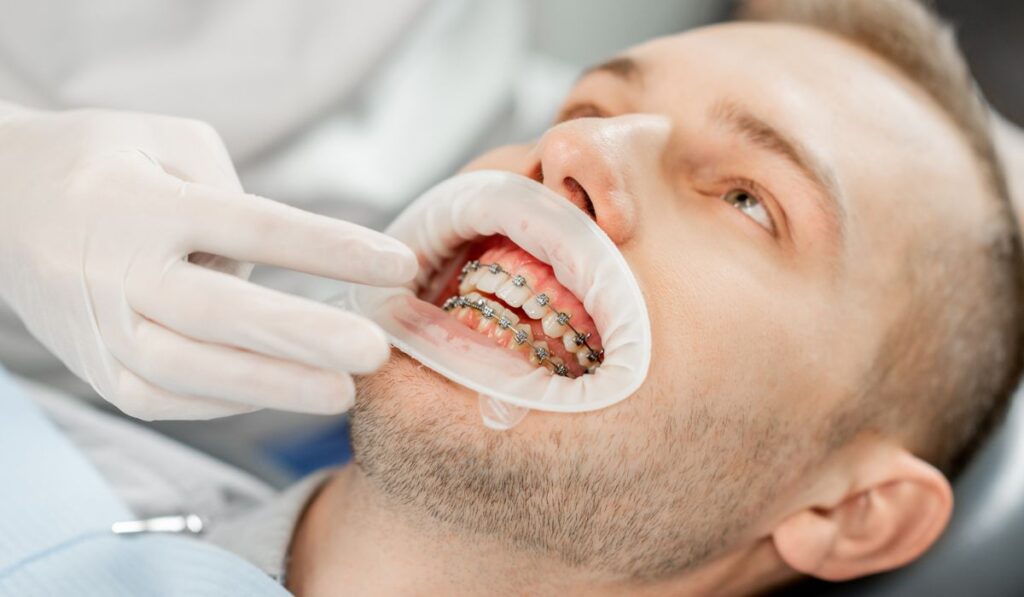If you have braces, your teeth are prone to many dental issues. Unfortunately, one of these issues is enamel erosion, which makes your teeth vulnerable to fractures and cavities. So, how can you prevent your braces from weakening your enamel?
You can prevent your braces from weakening your enamel by avoiding acidic and sugary foods and beverages, and by using products with fluoride. Observing exceptional dental care by regularly visiting the dentist for cleanings and brushing your teeth after meals will also help.
There are always risks when it comes to dental procedures. Complications could occur as a result of your dental treatment. Let’s get started so you know what a weakened enamel looks like, how you can prevent enamel erosion, and how to restore your enamel after braces.
Can Braces Cause Enamel Loss?

Braces can cause enamel loss, among other dental problems, if you aren’t focused on oral care by regularly brushing and flossing or watching what you eat. But not by themselves.
Braces spectacularly straighten your smile and correct jaw problems that lower your self-confidence and overall wellness using the wires and brackets, which are fundamental to the treatment process.
However, these wires and brackets make removing the food particles that adhere under, between, and on them difficult. After a while, these food particles build up and expel acidic content that eats away at your teeth’ enamel.
What Does Weakened Enamel Look Like?
One of the earliest indications of a weakened enamel is sensitivity. You’ll start feeling pain or discomfort when eating something sweet, hot, or cold. This results from the more sensitive dentin being exposed as the enamel erodes. While there are methods for managing the pain, it is best to avoid tooth sensitivity whenever possible.
Another sign of enamel erosion due to braces is the formation of bright white or yellow lesions on the enamel around the brackets and under the wires.
Diet and Lifestyle
A change in the color of your teeth is another one. This frequently occurs first on the central incisors, where you might observe that they’ve become a bit transparent on the edges. Then, as the enamel keeps on eroding, your teeth appear grayish or yellow.
Your teeth may also start to look rounded, form ridges, and the gaps between them become wider. Eventually, you might spot cracks in the teeth or lose a part of your tooth.
How to Prevent Enamel Erosion with Braces
Diligent dental care can significantly affect your teeth post orthodontic treatment. Here are some of the best ways to prevent enamel erosion with braces:
Avoid Sugary and Acidic Foods and Beverages
Paying attention to what you consume is one of the best things you can do to take care of your teeth with braces. A poor diet containing sugary and acidic foods could harm your teeth during orthodontic treatment. Therefore, it’s best to avoid eating acidic and sugary foods as much as possible.
Sugary foods cling to your braces, stay there for some time and damage your enamel since sugar stimulates the bacteria that cause tooth decay.
On the other hand, when overly acidic foods and drinks come into contact with your pearly whites, they lead to acid erosion that damages your tooth enamel.
Some foods and drinks are more acidic than others. Low-acid foods are better for your teeth, while some high acidic counterparts are good for your body. So, during the orthodontic treatment, concentrate on eating foods that are both good for your body and teeth.
Overly acidic foods and drinks include apples, pears, peaches, cherries, plums, oranges, pineapples, tomatoes, raspberries, soft drinks, fruit drinks, pickles, vinaigrette dressings, salsas, and barbeque sauces.
More tooth-friendly food and drinks include mangoes, bananas, carrots, melons, milk, water, cucumbers, beets, lettuce, meat, eggs, poultry, seafood, crackers, pasta, and soups.
Wait Before Brushing Your Teeth After Meals
If you’ve consumed sugary or acidic food or drink, wait for around 30 minutes before brushing your teeth. Dentists highly recommend you do this because if you brush immediately, the enamel is vulnerable to acid, and the bristles do more damage. Instead, rinse with water and then brush later at the appropriate time.
After brushing with the regular toothbrush, use a proxabrush (on Amazon)––a Christmas tree brush––to clean between brackets. Put the proxabrush between two brackets, just below the archwire, and brush up and down. Do this repeatedly until you clean your entire mouth.
Use Fluoride
Fluoride strengthens your teeth’ enamel and helps prevent enamel erosion. Ensure you regularly expose your teeth to fluoride by using fluoride toothpaste and mouthwash. And don’t worry, this isn’t anything special, brands like Colgate Max Fresh (on Amazon) and Listerine (also on Amazon) contain fluoride already – just check the label of the products you’re using or purchasing to make sure.
Visit the Dentist Regularly

Schedule routine teeth cleanings with your dentist, as your teeth are more susceptible to decay when you have braces. Most dentists usually recommend more than only two cleanings per year. You could jeopardize your dental health if you’re not routinely visiting the dentist for cleanings yet have braces.
How Can You Restore Enamel After Braces?
If your enamel goes through too much damage after braces, it becomes difficult, if not impossible, to strengthen it back to its original state. However, in some cases where your enamel is slightly weakened, you can do the following to ensure your enamel rehardens naturally:
Brush Using a Fluoride Toothpaste
Weak enamel requires minerals like calcium to rebuild itself. The only ingredient that effectively strengthens teeth is remineralizing toothpaste infused with fluoride.
Crest’s Gum & Enamel Repair Advanced Whitening (on Amazon) can help repair your enamel, remove surface stains, and eliminate bacteria.
Chew Sugar-Free Gum
Chewing gum lacking any sugars stimulates more saliva production. The saliva washes away harmful plaque bacteria. So be sure to get sugar-free gum, as sugar promotes bacterial growth, which we’re trying to fight.
Use a Fluoride Mouthwash
Adding a specialized fluoride-infused remineralizing mouthwash to your oral care routine helps fortify your enamel. In addition, mouthwash eliminates bacteria and sugars, while remineralizing properties are hard at work.
The remineralization process usually takes around three to four months to come into effect. Once the enamel starts fortifying, you’ll notice your teeth are getting stronger, experiencing less sensitivity, and your smile becomes whiter.


